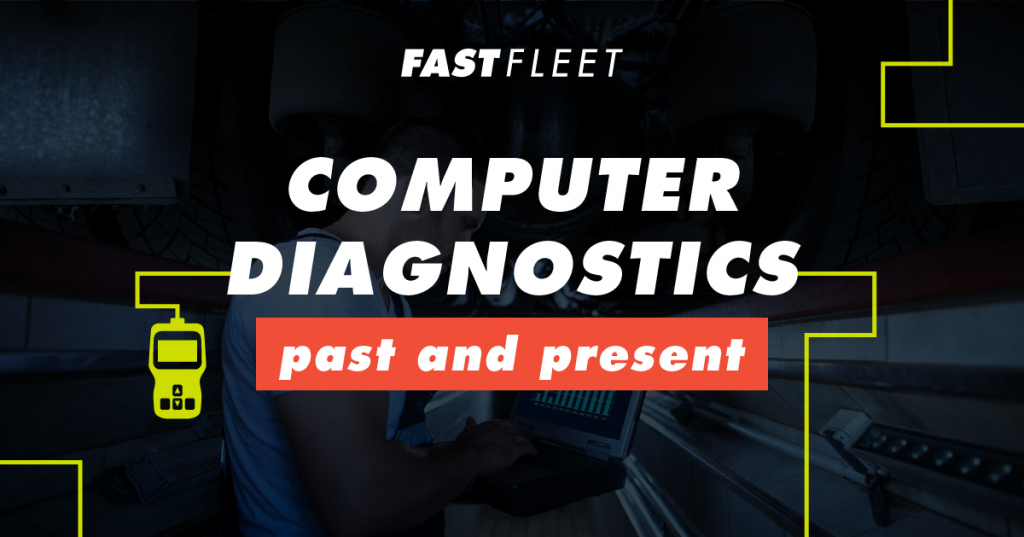Diagnostic work is a term used to describe the method in which a mechanic inspects a malfunctioning vehicle to pinpoint where the problem lies. Performing diagnostic work takes a skilled mechanic that is knowledgeable in every area of a vehicle. For fleet services, proper diagnostic work is especially important.
When companies contract the services of a fleet maintenance company, their goal is to receive high-quality work at a fair price.
What Are Computer Diagnostics?
Before the age of computers, diagnostic work had the potential to take substantially long periods of time. It’s a trial-and-error process that consists of the mechanic testing components and ruling out certain parts as they progress further with the inspection.
Today every vehicle manufactured contains a computer under the hood that holds the information for every component imaginable. These are central mainframes that provide the car with instructions on performing every major function within the vehicle’s ability.
This provides great convenience for present-day repair services. The mechanics that perform repairs can diagnose an issue with a vehicle by plugging the car into a scanner. The scanner will pull information from the computer and give the mechanic a list of codes for potential issues. These scanners have online access, allowing the mechanic to use these codes in a database that gives them the exact problem and solution.
But like we stated earlier, it hasn’t always been this easy for the world of auto-repair. Let’s take a look at the history of computer diagnostics.
History of Computer Diagnostics
You have to rewind back to 1968 to get to the beginning of computer systems for vehicles. Volkswagen included a computer on one of their compact car designs. This computer could be scanned, and the world was introduced to the first onboard diagnostic system.
Fast forward to 1975. Datsun began including diagnostic computers in their vehicles with the intent of calibrating the fuel injection system. At this point, there was no par for the course when it came to computer diagnostics.
In 1980 General Motors created a system for testing the Engine Control Module while the vehicle was still on the assembly line. This was known as the Assembly Line Diagnostic Link.
The Society of Automotive Engineers proposed that every vehicle contained a set of diagnostic connectors which allowed them all to be scanned for repairs. In 1991, what was known as OBD 1 was introduced, making it mandatory for all California vehicles to be manufactured with diagnostic capabilities. Finally, in 1996, OBD 2 made it mandatory that every vehicle sold in the United States could be linked to a diagnostic machine.
It wasn’t until 2005 that the EPA required larger trucks to have OBD capabilities. Slowly but surely, these requirements were passed between 2006 and 2010.
Initially, OBD scanners were incredibly expensive. However, as more vehicles were manufactured with these capabilities, these readers and scanners became more affordable.
Why Was This Development So Important?
There are several reasons why the adoption of these OBD systems was so important.
- Emissions: The biggest reason for the initial development of these systems was for emissions control. When they were first released, the primary purpose of these diagnostic components was to test for any failure on the vehicle that could lead to increased emissions.
- Electronic Fuel Injection: In the 1980s, more vehicles were released that were equipped with electronic fuel injection systems. These computer systems monitored the fuel flow to the engine. Readers and scanners could diagnose any issues with the entire system.
- Electronic Components: Vehicles slowly began their shift to electronic control. More sophisticated vehicles that were entirely dependent on computers required more sophisticated computer diagnostic machines.
The Difference Between Readers and Scanners
Before you learn anything more about big truck computer diagnostics, it helps to have an understanding of the differences between a reader and a scanner. Code readers are OBD2 devices that read and clear codes from vehicles that are installed with an onboard computer.
Scanners are much more efficient. As we mentioned previously in the article, scanners can give the user manufacturer-specific codes and access to live databases and solutions.
Scanners are typically the preferred tool for any roadside fleet maintenance company. With all of this in mind, let’s examine exactly how these scanners work in conjunction with the OBD system to diagnose problems.
Code Readers
Code readers normally come with a free service that has a list of codes to help the user diagnose problems. This database is much smaller than that of a scanner and is normally connected to a local parts store. Some scanners require the user to search the internet manually to find the meaning of these codes.
Pros
- Wide price range for all budgets and uses
- Can be very affordable with some models as low as $30
Cons
- Not as advanced or comprehensive as scanners
Scanners
Scanners are more expensive than readers but are more appropriate for professional mechanics and high-level car enthusiasts. These scanners offer a much larger range of manufacturer-specific codes and offer troubleshooting tips as well. There are much larger databases that scanners can connect to. These databases normally have to be paid for and downloaded in the form of software.
Pros
- The accuracy
- More sophisticated than readers
- Most have data-playback and diagnostic instructions
Cons
- Expensive with a steeper learning curve
The Bottom Line
Professional mechanics will find that scanners are much better suited for the scope of the job they need. Scanners cover a much larger range of vehicles and provide access to a more comprehensive database. The scanner’s information is more detailed, giving a mechanic a much better chance of properly diagnosing the vehicle.
Different Types of Scan Tools Broken Down
Code Readers
As we mentioned earlier, code readers provide users with OBD 2 generic information. They can pick up and quickly clear Diagnostic Trouble Codes (DTC), but they are limited to only engine and PCM information.
Enhanced Scan Tools
Enhanced scan tools provide a much larger amount of information on the vehicle. Code readers and standard OBD 2 scanners only provide emissions information. Enhanced scan tools provide information on the transmission, ABS, SRS, air conditioning system, and much more. Some vehicles have as many as 75 modules that can put information out regarding different components of the vehicle.
Heavy-Duty Scan Tools
Heavy-duty scan tools are made specifically for larger vehicles such as tractor-trailers. These scanners don’t scan for information based on the year, make, and model. Instead, they use the class system to break vehicles down. The vehicles are separated by classes 4 through 6.
How Does OBD Work?
The OBD system works by operating on a primary central mainframe with a network of sensors sending and receiving signals to and from the computer. Listed below are the working parts of the OBD system:
ECU
The ECU is the main part of the OBD system. This is also known as the Electronic Control Unit. This collects input from different sensors and sends the data to different parts of the vehicle, like fuel injectors and other areas.
Sensors
Sensors cover the vehicle anywhere from the engine to the chassis. Each of these sensors sends codes to the ECU. The ECU then reads these codes, interpreting a signal that allows it to alert the user to the source.
DTC
If a sensor sends information to the ECU that isn’t saved into the scanner, it’s known as a Diagnostic Trouble Code. Sometimes these codes are manufacturer-specific. Since no specific code has been sent, normally, this problem is solved by linking the sensor directly to the OBD system.
MIL
When the ECU picks up on a DTC code, a signal is sent to the vehicle’s dashboard that tells it to turn on the appropriate warning light. These lights are known as MILs or Manufacturer Indicator Lights. These provide early warnings to the vehicle to let the user know maintenance needs to be performed. These lights can include the check engine light, transmission warning light, oil change light, tire pressure maintenance lights, and others. Normally if the light just turns on, the problem is not that serious. However, if the light is flashing, it could indicate that the problem is more severe.
DLC
The DLC is the point of access where a scanner can be hooked up to read the vehicle’s computer. These points are normally located beneath the steering column or somewhere in that general area.
Why Is OBD Important to Commercial Vehicles
- Fast diagnosis: When a commercial vehicle is stranded on the side of the road, a fast diagnosis is essential to getting the driver and vehicle moving again. Roadside technicians can plug the scanner in and receive a quick code, altering them to where the issue lies.
- Accurate info: There are many sensors installed throughout large fleet vehicles. This high number of sensors allows the scanner and computer to work together to diagnose the issue to a pinpoint location. These systems operate with very precise accuracy.
- Different metrics: These systems can also be used to track driver behavior and ensure they are operating under all legal requirements. This information can be relayed to their main dispatch, allowing them to monitor their drivers remotely for safety and maintenance standards.
- Compliance: The EPA has developed many regulations based on the size and weight of certain vehicles. For example, any large truck over 14,000 pounds needs to be inspected regularly to ensure it meets the appropriate requirements.
- Saves money: Because these systems give real-time updates to vehicle owners and mechanics, problems can be found long before they can get severe and damage other systems of the vehicle.
What’s the Best Heavy-Duty Scan Tool for Fleet Maintenance Companies?
One of the most widely used manufacturers of heavy-duty scan tools is Noregon. The JPRO computer diagnostic tool is very efficient in diagnosing larger, commercial vehicles. This is one of the go-to scanners for companies that manage larger fleet services. Let’s examine what makes the JPRO so popular.
The Noregon JPRO
This cutting-edge diagnostic machine is one of the best in the large vehicle repair and fleet services industry. These are some of the benefits of using this machine:
- The machine provides digital photos, allowing the user to get a perfect visual of the part in question.
- Users can map out trouble areas with detailed information about the component location on the vehicle.
- The interface includes detailed wiring diagrams specific to each make and model.
- The machine has a connector view, giving a user an up-close look at where connections are made between wires and components.
- There is very detailed information regarding the installation and removal of all the parts and components researched with this scanner.
It’s clear to see that this amazing machine has changed how diagnostic work is done on large vehicles. There is also a mobile version of the JPRO, allowing traveling technicians to take this cutting-edge technology on the road with them to service emergency calls. This is a game-changer considering in the past large vehicles had to be towed to a shop for any diagnostic work to be done on them.
This greatly improves the efficiency and reliability of fleet management repair services. Towing a vehicle is expensive and time-consuming; the JPRO can eliminate these issues and allow a technician to remotely diagnose and fix major issues.
Biggest Invention in Auto Repair History?
OBD and computer diagnostic technology changed the way mechanics fix our vehicles decades ago and continue to do so today. The manufacturers of this technology have done a great job at keeping up with car manufacturers’ rapid advancements in their vehicle lineups.
As time progresses, vehicle makers continue to add smart technology and other advanced components to vehicles. There’s no doubt that scanners and OBD technology will continue to advance as well.
It’s certainly not a stretch to say that the OBD system and adoption of vehicle computer scanners are possibly the most important invention in auto repair history. Not only did they make diagnosing and fixing vehicles easier, they completely changed the way mechanics perform auto repairs on vehicles altogether.
Resources
















